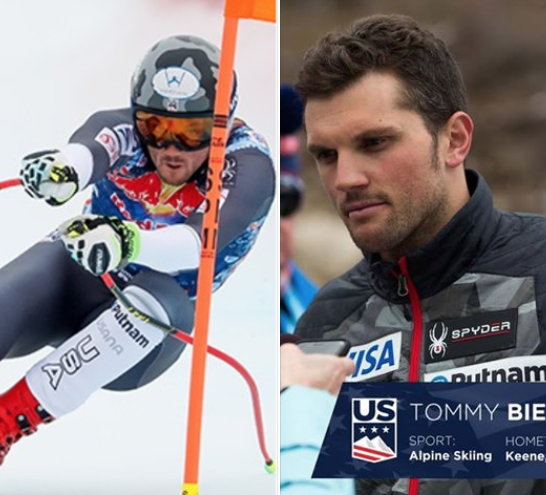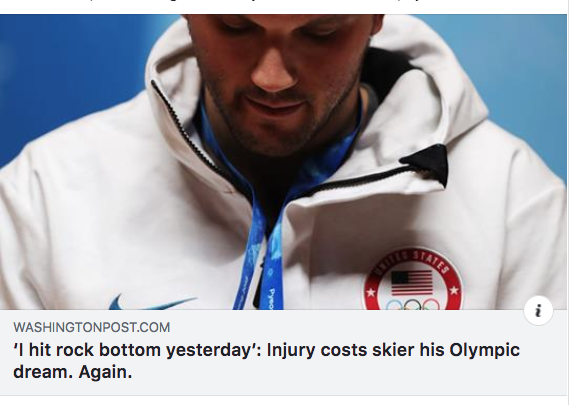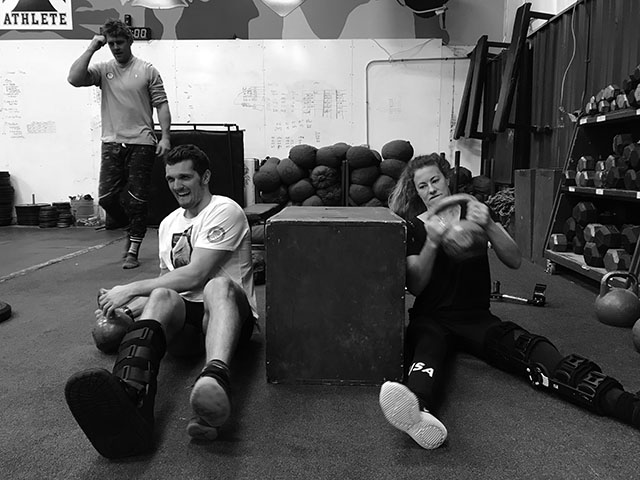
By Thomas Biesemeyer
There is a quiet sense of positivity within yourself when you accept injury and commit to a surgical repair. Your self-belief and confidence are high because after surgery the ball is finally in your court and that is ultimately everyone’s goal: control. What no one ever thinks is that when signing that piece of paper before getting wheeled in for surgery there is a small risk for infection. But does anyone actually become concerned with that? The internal belief is, “that kind of stuff doesn’t happen to people like me”. But I couldn’t have been more wrong.
After four days of cancellations at the 2018 Olympic Downhill due to weather, the race organizers decided that an additional training run was needed to ensure a safe and fair race. It was on this run that I crashed and tore my Achilles tendon, and just like that my Olympic debut was sidelined. Injuries have been a sore topic of conversation when talking about my career so this was not a foreign environment for me.
I flew back to our team’s orthopedic surgeon in Vail, Colorado for an immediate surgery and was told I would be “back in no time, skiing in five months.”
 Three weeks post-operation I started feeling that something was wrong with my rehab; I was having high levels of pain, weird bumps on my scar, and no progress when it came to my range of motion and strength. Unfortunately, I was right. I had an infection but it took five months for the doctor to accept it and treat it properly. At four weeks post-op, I went back in for a second surgery but nothing seemed “too alarming” so the doctors simply cleaned it out and put me on a PICC line (antibiotics intravenously), and I assumed I was fixed. As time went on, roughly three months, my scar kept opening through two distinct holes and oozing, which was disconcerting but my doctor assured me that everything was okay. Another two months passed and the holes were still very much there, but with no associated pain. With mounting doubt in my mind I decided to go back to the doctor for his assessment.
Three weeks post-operation I started feeling that something was wrong with my rehab; I was having high levels of pain, weird bumps on my scar, and no progress when it came to my range of motion and strength. Unfortunately, I was right. I had an infection but it took five months for the doctor to accept it and treat it properly. At four weeks post-op, I went back in for a second surgery but nothing seemed “too alarming” so the doctors simply cleaned it out and put me on a PICC line (antibiotics intravenously), and I assumed I was fixed. As time went on, roughly three months, my scar kept opening through two distinct holes and oozing, which was disconcerting but my doctor assured me that everything was okay. Another two months passed and the holes were still very much there, but with no associated pain. With mounting doubt in my mind I decided to go back to the doctor for his assessment.
At five months post my initial surgery (which was February 19th) I surrendered to a third surgery. The difference between the third operation and the previous two was an additional surgeon. Throughout this whole process, I started to ask for opinions from other surgeons and when going in for the most recent surgery I requested that another surgeon join because he had a keen sense of what needed to be done, and an aggressive approach towards my infection that I appreciated. In this surgery, I had all of my hardware taken out, and two cultures came back positive for Staph. I had an infection.
Since my health insurance is provided by the USOC (United States Olympic Committee) it was required that the staph be reported and I consult with an infectious disease doctor. For seven weeks I would meet this doctor in Salt Lake City to get my healing scar accessed and blood work done to make sure I had proper kidney function due to the prescribed high dosage of antibiotics.
It is safe to assume that most people are impatient and like control; I myself am very much grouped into this category and the Achilles rehab has tested both of these characteristics. During rehab, I went from thinking I was going to be skiing in record time to wondering if I would even ski race this upcoming season, or worse, ever again. That may sound dramatic, but when an infection presents itself efforts to rid it become seemingly desperate, and doctors once seen as confident and all-knowing now appear uncertain. It’s not a position anyone wants to be in when dealing with one’s health.

At this point, I realized that my mental resilience, much like my Achilles, was not as strong as I needed it to be. I believed I would get better and come back stronger than ever. But when time started to slip away and my recovery was eating into my scheduled time on snow, I felt doubt and negative energy from teammates, coaches, and sponsors. At this low point, I became more patient and calm. I had to. Instead of succumbing to the self-doubt prolonged recovery I used rest as if it was training. I worked my able body parts with purpose, I ate as well as I could, and I believed in my healing day by day. I had moments of weakness where I thought all was lost, but I never let it become enough to alter my overall outlook.
Currently, I am in Solden, Austria training on snow and feel great. My Achilles is not perfect, but the daily mileage is fueling my confidence that I will be able to compete again at a high level. I still randomly wake up in the middle of the night with a feeling that my scar is oozing and have to remind myself that it is fine. I guess that is the self-doubt and pessimism often affiliated with an injury. I have learned that this whole ordeal is a process, each step I have taken to this point has been important, and the coming steps will eventually lead me to my ultimate goal of standing on top of the podium. My understanding of being able to give a little to gain a lot has been extremely critical during this rehab. The ability to be patient and calm while sitting on a couch when I think I should be training with full intensity is hard -really hard- but looking back I am thankful I was able to do it because it got me to where I am today.
Thomas is a downhill specialist on the US Ski Team.
You Might Also Like What to Program for Just 2 Weeks with an Olympic Ski Racer?
